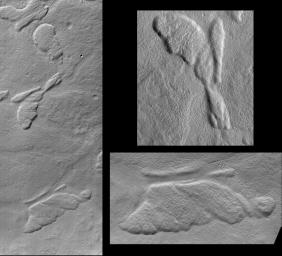
|
Hot Dog and Butterfly, Nereidum Montes
- Click the image above for a larger view
- Full-Res JPEG (837 x 762) (97.4 kB)
- Full-Res TIFF (837 x 762) (465.4 kB)
Caption:
Some of the pictures returned from Mars by the Mars Orbiter Camera (MOC) onboard the Mars Global Surveyor (MGS) spacecraft show features that--at a glance--resemble familiar, non-geological objects on Earth. For example, the picture above at the left shows several low, relatively flat-topped hills (mesas) on the floor of a broad valley among the mountains of the Nereidum Montes region, northeast of Argyre Planitia. One of the mesas seen here looks like half of a butterfly (upper subframe on right). Another hill looks something like a snail or a hot dog wrapped and baked in a croissant roll (lower subframe on right). These mesas were formed by natural processes and are most likely the eroded remnants of a formerly more extensive layer of bedrock. In the frame on the left, illumination is from the upper left and the scene covers an area 2.7 km (1.7 miles) wide by 6.8 km (4.2 miles) high. The "butterfly" is about 800 meters (875 yards) in length and the "hot dog" is about 1 km (0.62 miles) long.
Background Info:
Malin Space Science Systems and the California Institute of Technology built the MOC using spare hardware from the Mars Observer mission. MSSS operates the camera from its facilities in San Diego, CA. The Jet Propulsion Laboratory's Mars Surveyor Operations Project operates the Mars Global Surveyor spacecraft with its industrial partner, Lockheed Martin Astronautics, from facilities in Pasadena, CA and Denver, CO.
Cataloging Keywords:
| Name | Value | Additional Values |
|---|---|---|
| Target | Mars | |
| System | ||
| Target Type | Planet | |
| Mission | Mars Global Surveyor (MGS) | |
| Instrument Host | Mars Global Surveyor | |
| Host Type | Orbiter | |
| Instrument | Mars Orbiter Camera (MOC) | |
| Detector | ||
| Extra Keywords | Dust, Grayscale, Mountain | |
| Acquisition Date | ||
| Release Date | 2000-09-16 | |
| Date in Caption | ||
| Image Credit | NASA/JPL/MSSS | |
| Source | photojournal.jpl.nasa.gov/catalog/PIA01684 | |
| Identifier | PIA01684 | |
